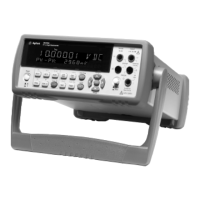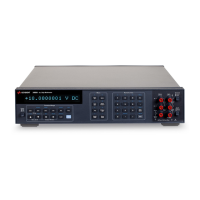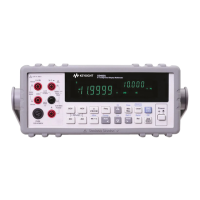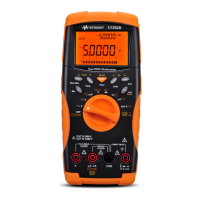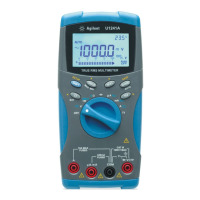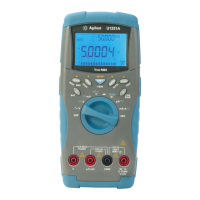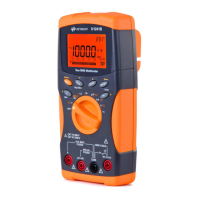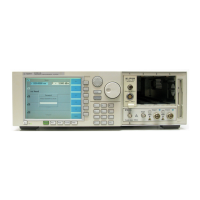33
DC Voltage
Measurement Method:
Continuously integrating multi-slope III
A-D converter
A-D Linearity: 0.0002% of reading +
0.0001% of range
Input Resistance:
10 MΩ or 0.1 V, 1 V, 10 V ranges:
Selectable > 10,000 MΩ
100 V, 1000 V ranges: 10 MΩ ±1%
Input Bias Current: < 30 pA at 25°C
Input Protection: 1000 V all ranges
dcV:dcV ratio accuracy:
V
input
Accuracy + V
relevance
Accuracy
True RMS AC Voltage
Measurement Method:
AC-coupled true rms-measures the ac
component of the input with up to 400
Vdc of bias on any range.
Crest Factor:
Maximum of 5:1 at full scale.
Additional Crest Factor errors
(non-sinewave):
Crest factor 1-2: 0.05% of reading
Crest factor 2-3: 0.15% of reading
Crest factor 3-4: 0.30% of reading
Crest factor 4-5: 0.40% of reading
Input Impedance:
1 MΩ ± 2% in parallel with 100 pF
Input Protection:
750 Vrms all ranges
Resistance
Measurement Method:
Selectable 4-wire or 2-wire Ohms.
Current source referenced to LO input.
Maximum Lead Resistance (4-wire):
10% of range per lead for 100 Ω, 1 kΩ
ranges.
1 kΩ per lead on all other ranges.
Input Protection: 1000 V all ranges
DC Current
Shunt Resistance:
5 Ω for 10 mA, 100 mA
0.1 Ω for 1 A, 3 A
Input Protection:
Externally accessible 3 A 250 V fuse
Internal 7 A 250 V fuse
True RMS AC Current
Measurement Method:
Directly coupled to the fuse and shunt.
ac coupled true rms measurement
(measures the ac component only).
Shunt Resistance:
0.1 Ω for 1 A and 3 A ranges
Input Protection:
Externally accessible 3 A 250 V fuse
Internal 7 A 250 V fuse
Frequency and Period
Measurement Method:
Reciprocal counting technique
Voltage Ranges:
Same as ac voltage function
Gate Time: 1 s, 100 ms, or 10 ms
Continuity/Diode
Response Time:
300 samples/s with audible tone
Continuity Threshold:
Selectable from 1 Ω to 1000 Ω
Measurement Noise Rejection 60 (50) Hz
1
dc CMRR: 140 dB
ac CMRR: 70 dB
Integration Time and
Normal Mode Rejection
2
100 plc/1.67 s (2 s): 60 dB
3
10 plc/167 ms (200 ms): 60 dB
3
1 plc/16.7 ms (20 ms): 60 dB
<1 plc/3 ms or 800 µs): 0 dB
Operating Characteristics
4
Function Digits Reading/s
dcV, dcl, and 6
½
0.6 (0.5)
Resistance 6
½
6 (5)
5
½
60 (50)
5
½
300
4
½
1000
acV, acl 6
½
0.15 slow (3 Hz)
6
½
1 medium (20 Hz)
6
½
10 fast (200 Hz)
5
6
½
50
Frequency 6
½
1
or Period 5
½
9.8
4
½
80
System Speeds
Configuration rates: 26/s to 50/s
Autorange rate (dc Volts): >30/s
ASCII readings to RS-232: 55/s
ASCII readings to RS-232: 1000/s
Maximum internal trig rate: 1000/s
Max. ext trig. rate to mem: 1000/s
Triggering and Memory
Reading HOLD Sensitivity:
10%, 1%, 0.1%, or 0.01% of range
Samples/Trigger: 1 to 50,000
Trigger Delay: 0 to 3600 s: 10 µs step
size
External Trigger Delay: < 1 ms
External Trigger Jitter: < 500 µs
Memory: 512 readings
Math Functions
NULL, min/max/average, dBm, dB, limit
test (with TTL output)
Standard Programming Languages
SCPI (IEEE-488.2), Agilent 3478A,
Fluke 8840A/42A
Accessories Included
Test lead kit with probe, alligator
and grabber attachments
Operating manual, service manual,
test report and power cord
General Specifications
Power Supply:
100 V/120 V/220 V/240 V ±10%
Power Line Frequency:
45 Hz to 66 Hz and 360 Hz to 440 Hz,
Automatically sensed at power-on
Power Consumption: 25 VA peak
(10 W average)
Operating Environment:
Full accuracy for 0°C to 55°C,
Full accuracy to 80% R.H. at 40°C
Storage Temperature: -40°C to 70°C
Weight: 3.6 kg (8.0 lbs)
Safety: Designed to CSA, UL-1244,
IEC-348
RFI and ESD: MIL-461C, FTZ 1046, FCC
Vibration & Shock: MIL-T-28800E, Type
III, Class 5 (sine only)
Warranty: 1 year
Measurement Characteristics
1
. For 1 kΩ unbalanced in LO lead,
± 500 V peak maximum.
2.
For power line frequency ± 0.1%.
3.
For power line frequency ± 1% use 40 dB
or ± 3% use 30 dB.
4.
Reading speeds for 60 Hz and (50 Hz)
operation.
5.
Maximum useful limit with default settling
delays defeated.
6. Speeds are for 4½ digits, delay 0, auto-zero
and display OFF.
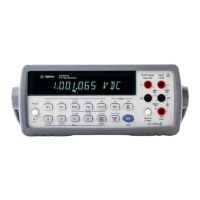
